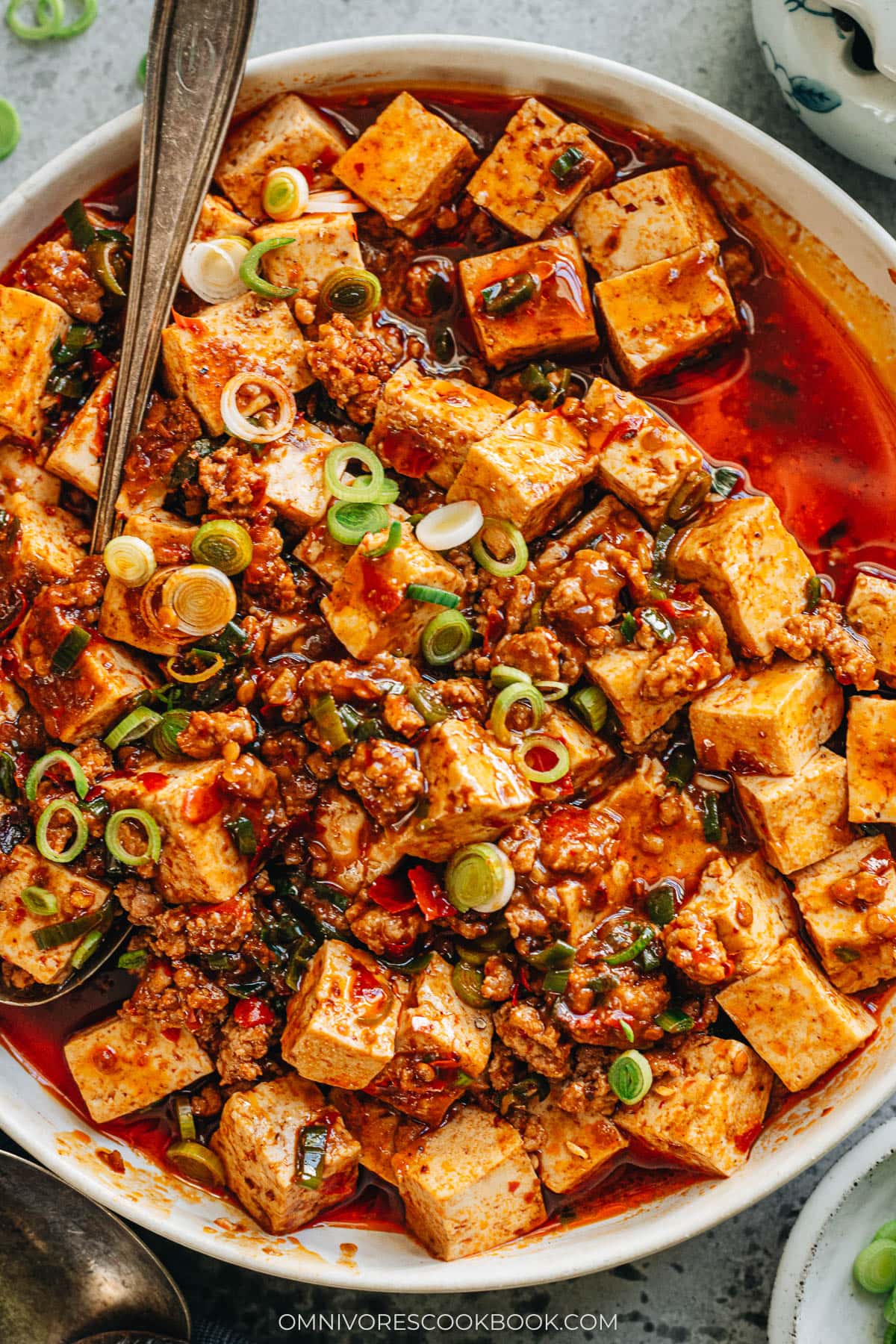
Mapo tofu (麻婆豆腐, ma po dou fu) is one of the most popular dishes from Sichuan cuisine. The tofu pieces are braised in a rich, spicy, savory sauce, along with fresh garlic and scallions. A small amount of ground pork enhances the flavor. The dish is so appetizing, and it goes perfectly with steamed rice.
Cooking mapo tofu is relatively easy, but you need a few special ingredients to get the authentic flavor. I’m sharing my favorite mapo tofu recipe below. It creates the very authentic taste that you’d get at a restaurant in China. However, you can easily tweak the dish according to your preferences.
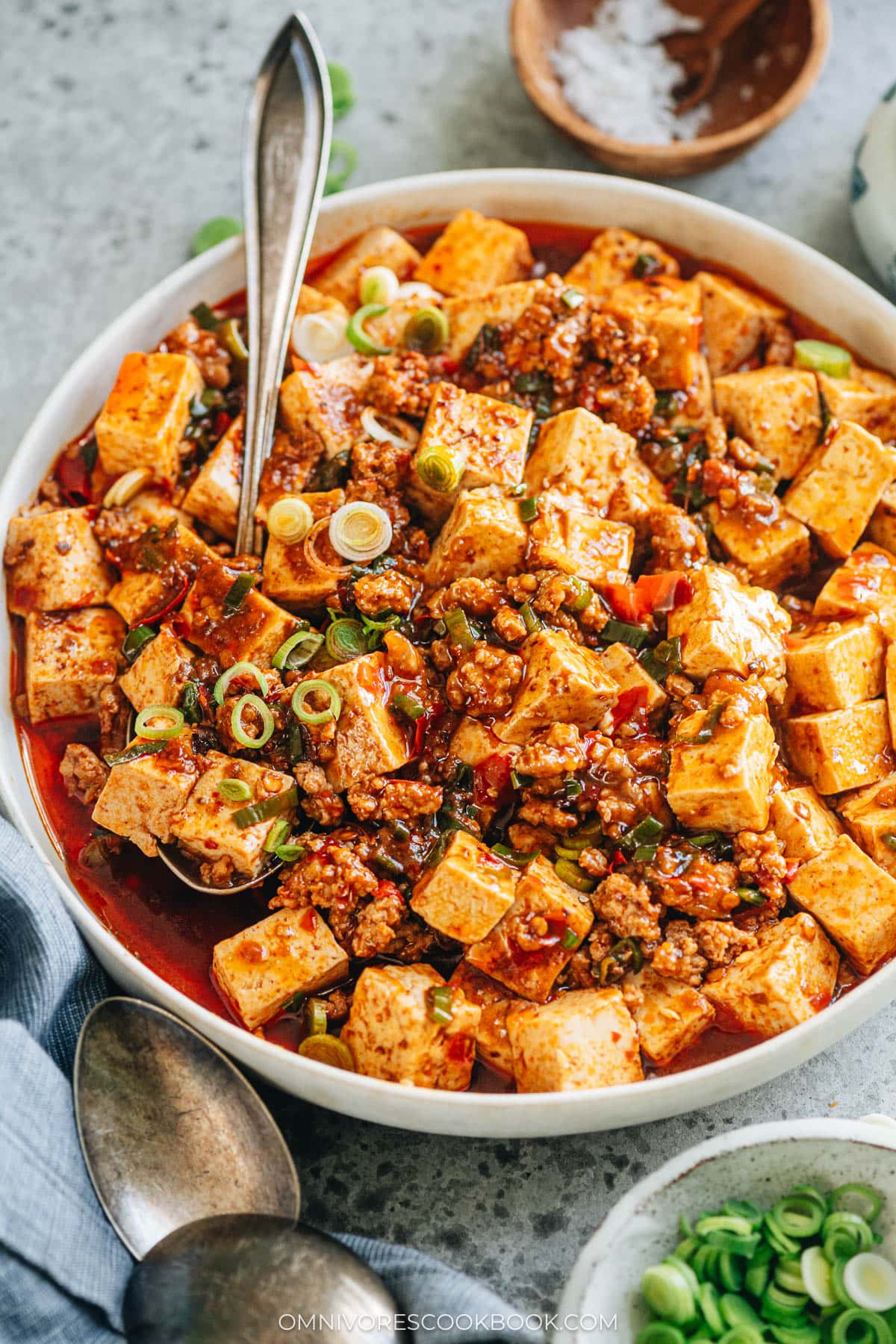
Key ingredients for Mapo Tofu
Doubanjiang
Doubanjiang (豆瓣酱), also known as spicy fermented bean paste, chili bean paste, chili bean sauce, or broad bean sauce, is the most crucial ingredient in mapo tofu. It has a strong, fermented, savory, salty, and spicy taste. Try to find “Pixian Broad Bean Paste” at your Asian market.Pixian is a small county in the Sichuan province that produces the best chili bean paste. If you’re using this brand, you’re already halfway there. You can also purchase this brand on Amazon here.
NOTE: The salt and spice level can vary greatly depending on the Doubanjiang brand. This dish is designed to be served with rice, so it’s on the salty side. To make your dish less salty and spicy, reduce the amount of Doubanjiang to 2 tablespoons.
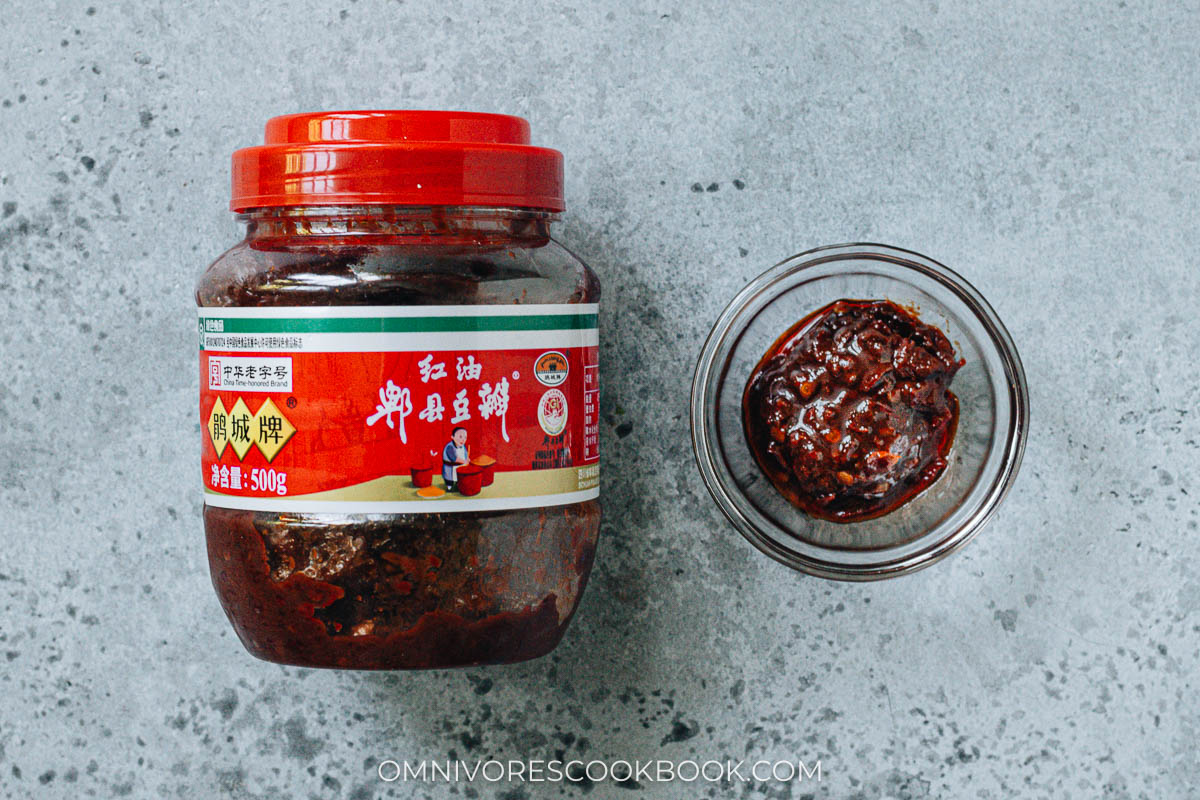
Sichuan peppercorns
Sichuan peppercorn (花椒, hua jiao) is another main ingredient in any Sichuan dish. It has a citrusy taste with a numbing tingling sensation when you chew on it. It’s a crucial and irreplaceable flavor-enhancing ingredient.. You can purchase Sichuan peppercorns at Asian grocery stores, but I highly recommend these premium fresh ones from The Mala Market.
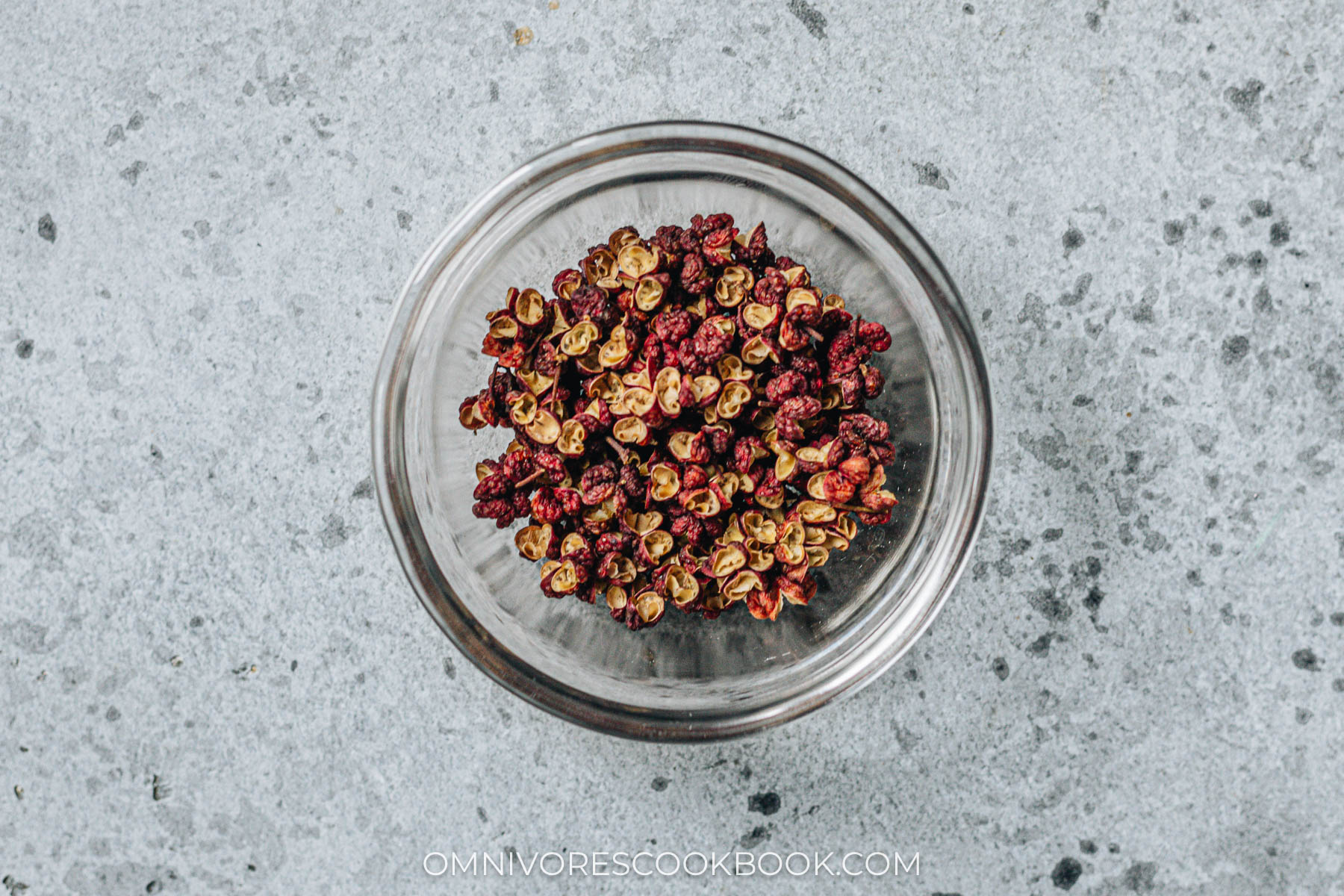
Sichuan peppercorn cooking tips
The most common way to cook Sichuan peppercorns is to fry them in hot oil. Doing so infuses the flavor and makes the dish milder. You can also grind the peppercorns and use them to garnish your dish later.
Alternatively, you can use ground-up fresh Sichuan pepper. I recently got a Sichuan peppercorn grinder from The Mala Market. I love that it’s fast and easy to use. Grind a small amount and add it when cooking or at the end to add flavor. If you have this product on hand, add 1/4 teaspoon ground Sichuan pepper when you add the ground pork.
When you use super fresh Sichuan pepper, the flavor is pungent. You may only need about half of the amount indicated in this recipe. The longer you store the peppercorns, the less fragrance they will have, and the more you need to use.
Homemade chili oil
The other essential ingredient is homemade chili oil (辣椒油). Freshly cooked chili oil tastes much better than store-bought and is free of additives. It only takes a few minutes to cook, and it’s really easy.
If you want to purchase chili oil, make sure to find a high quality one. And it should contains chili flakes and the oil, such as this one.
What to do with leftover chili oil?
You will usually cook more chili oil than you’ll use in one meal. You can store the extra oil in an airtight container in the fridge for 6 months to a year. Use it in various dishes, including Sichuan spicy wonton in red oil and Fu Qi Fei Pian (sliced beef in hot sauce). You can also add it to a dipping sauce for potstickers, to wonton soup to enhance the flavor, or even put it on oatmeal!
It might look like you need so many specialty ingredients for this one dish. But trust me, if you love Sichuan food, you’ll use them repeatedly.
How to cook mapo tofu
Fry the Sichuan peppercorns in the oil to infuse the aroma
- Fry the Sichuan peppercorns in the oil to infuse the aroma.
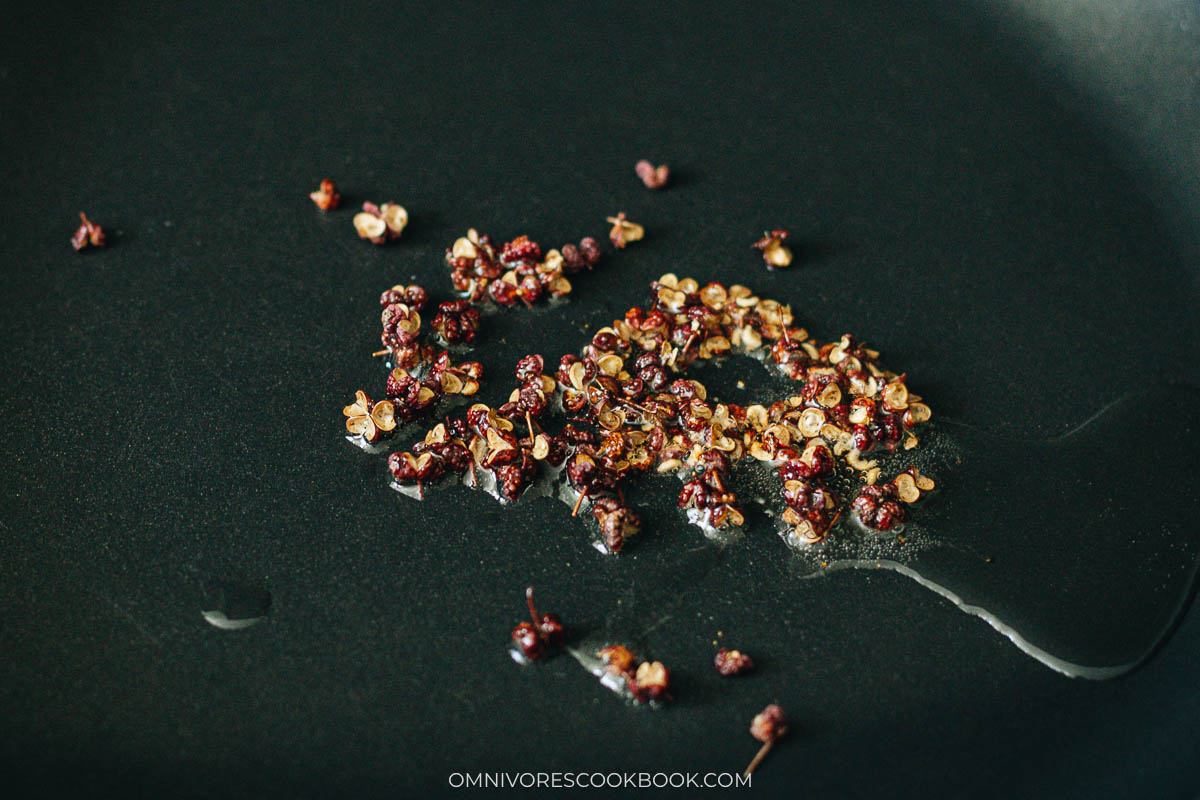
- Cook the ground pork with doubanjiang.
- Once the pork is cooked, add the green onions and stir a few times.
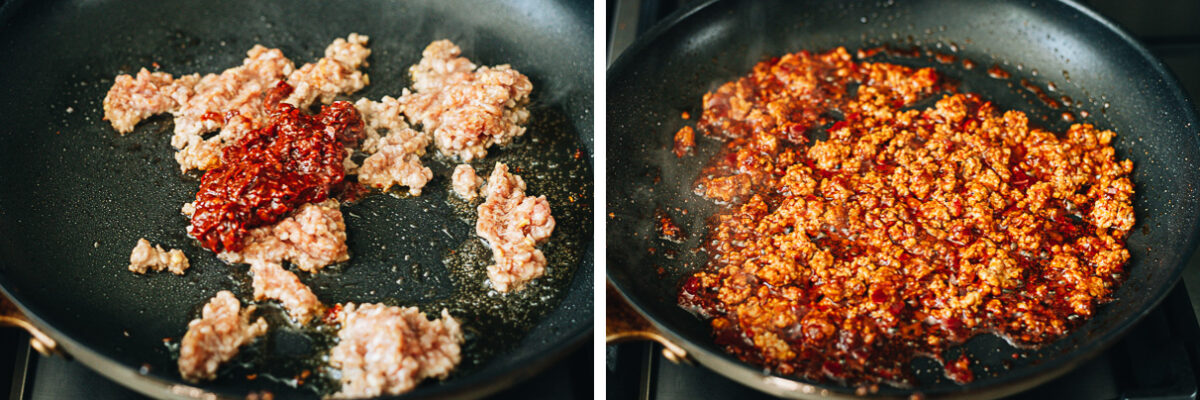
- Add the broth, tofu cubes, and braise with the cover on.
- Drizzle in the cornstarch mixture to thicken the sauce. Sprinkle with scallion greens for garnish.
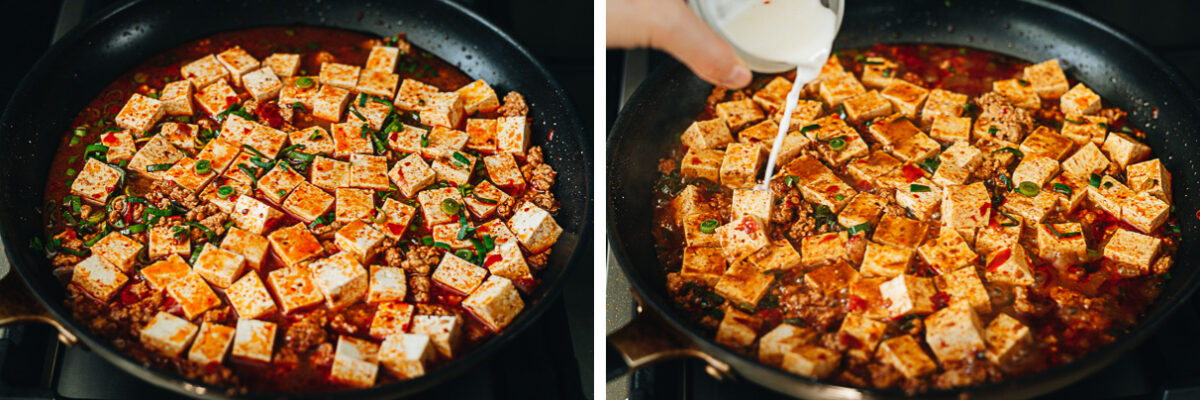
That’s it! I think this is one of the easiest Sichuan recipes, and the result is super rewarding 🙂
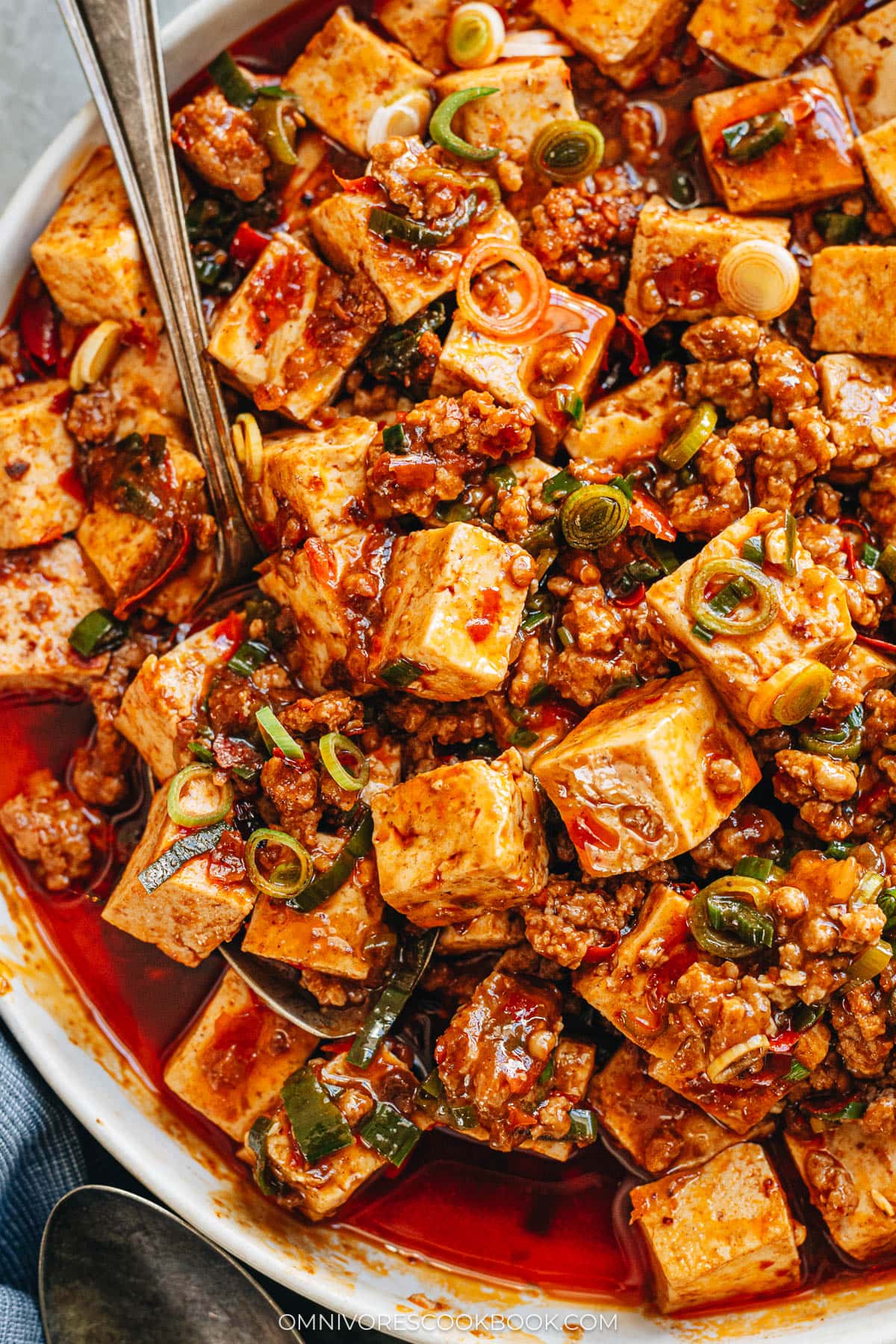
How to serve mapo tofu
I love cooking mapo tofu for a quick lunch or dinner and serving it over steamed rice. Sometimes I double the meat and sauce, so it will be enough to serve two people as a one-dish meal.
I also like to add a handful of greens (spinach, garlic chives, or other tender greens such as chopped up baby bok choy) at the end of braising before adding the cornstarch, to create a more nutritious and balanced meal. Sometimes I also replace the ground pork (used in the authentic version) with ground beef, or ground chicken, depending on what I have in the fridge.
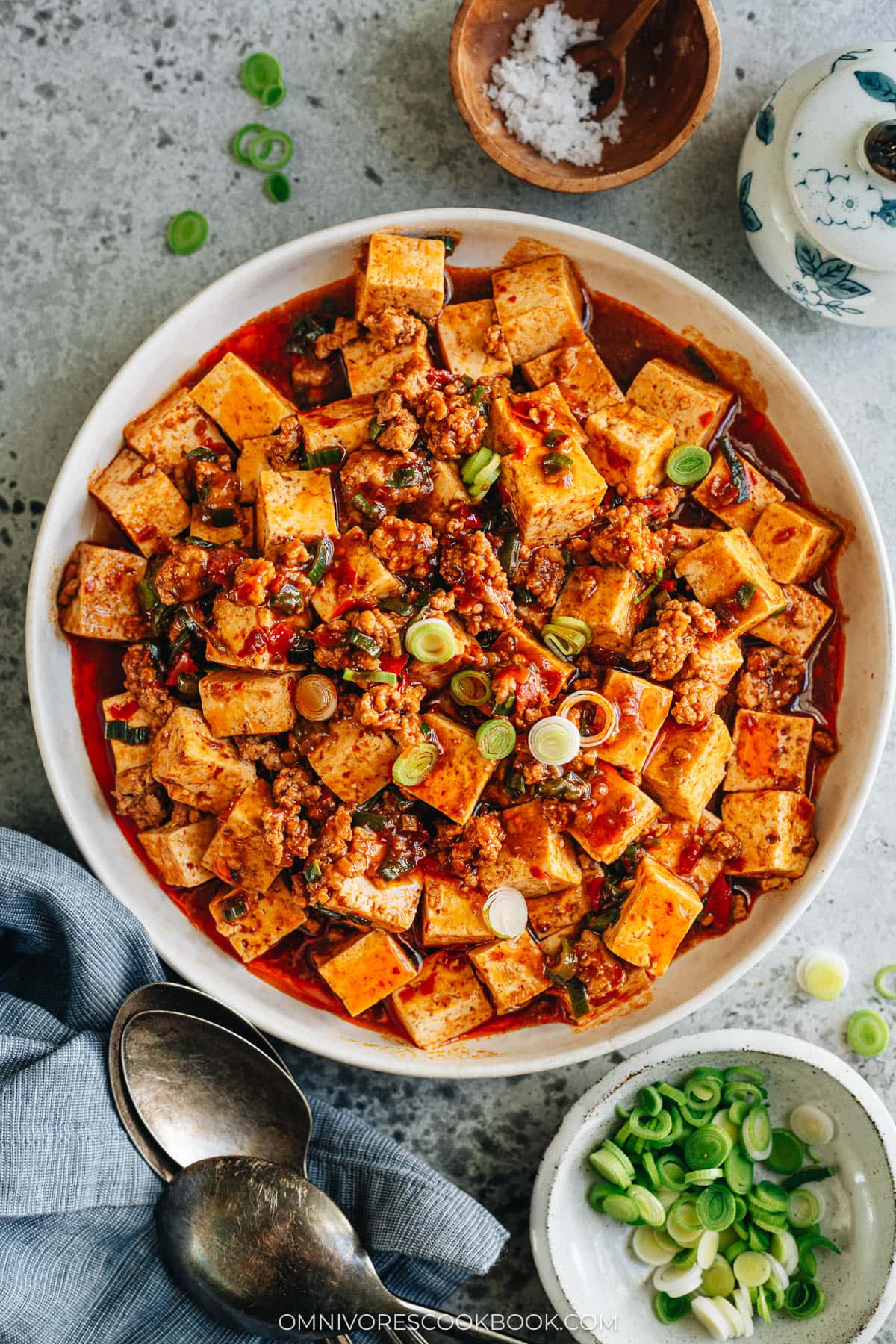
Frequently asked questions
What type of tofu should I use for mapo tofu?
There is no correct answer; you should choose what works best for you. Some Chinese restaurants, including many in China, prefer soft or silken tofu for a melt-in-your-mouth texture. This method requires some experience handling tofu, so you won’t break apart the delicate silken tofu while cutting and cooking.
This dish can also use extra firm, firm, or medium tofu, which is much easier to handle. Plus, once you braise the tofu in the rich, spicy sauce, it absorbs a lot of flavor and tastes great.
Do I need a wok to cook mapo tofu?
Not at all! I found it’s easiest to cook mapo tofu in a nonstick pan. The tofu will sit flat in the broth and absorb all the flavor. Plus, it won’t stick to the pan or fall apart when you stir it.
How do you make mapo tofu vegetarian or vegan?
I have a vegan mapo tofu recipe here that tastes super flavorful!
Chinese Cooking Made Easy
Are you new to this website? This free email series is a great place to start. I’ll walk you through a few of my most popular recipes and show you how and why they work. You’ll quickly start to cook better Chinese food in your own kitchen.
Watch video

Authentic Mapo Tofu (麻婆豆腐)
Ingredients
Marinating
- 4 oz ground pork (or chicken, or turkey) (*Footnote 1)
- 2 teaspoons Shaoxing wine (or dry sherry)
- 1 teaspoon light soy sauce
- 1/2 teaspoon minced ginger
For braising
- 1 teaspoon cornstarch (optional) (*Footnote 2)
- 2 teaspoons Sichuan peppercorns , increase to 3 teaspoons if you like your dish extra numbing, or reduce to 1 teaspoon if your Sichuan peppercorns are extra fresh
- 1 tablespoon peanut oil (or vegetable oil)
- 3 tablespoons Doubanjiang , reduce to 2 tablespoons for a less saltier and less spicy taste
- 2 green onion , chopped
- 1 block firm or medium firm tofu , cut into 1.5cm (1/2 inch) squares
- 1 cup chicken stock (or water)
- 2 teaspoons homemade chili oil (*Footnote 3)
- 1/4 teaspoon five-spice powder
- 1 teaspoon sugar (or to taste)
Instructions
- Combine ground meat, cooking wine, soy sauce, and ginger in a small bowl. Mix well.
- Combine cornstarch with 1 tablespoon of water in a small bowl. Mix well and set aside.
- Heat the oil and Sichuan peppercorns in a large nonstick skillet over medium-high heat. When the Sichuan peppercorns turn dark brown and crispy, scoop them out with a spatula and transfer into a bowl layered with paper towels to soak extra oil. Save to use for garnishing the dish (Optional).
- Add the ground meat and Doubanjiang. Cook over medium heat and chop the ground meat into small bits with a spatula, until pork is evenly coated with Doubanjiang and fully cooked through. Add green onion and stir fry for another minute.
- Spread tofu evenly on top of ground pork (*Footnote 4). Add chili oil, five-spice powder, and sugar. Pour in the broth and cook until brought to a simmer. Simmer, covered, over medium-low heat for 8 to 10 minutes, or until the sauce has reduced to half the original amount. Taste the tofu with some broth (be careful, it will be very hot!). Adjust seasoning by adding salt if needed. If the dish is too spicy, add another teaspoon of sugar to balance it out. Gently mix well with spatula.
- (Optional) Meanwhile, grind the fried Sichuan peppercorns (you used when heating up the oil) in a coffee grinder or using mortar and pestle.
- Mix cornstarch water again until fully dissolved and swirl it into the skillet. Gently stir a few times with a spatula, until sauce thickens. Turn off heat and transfer everything to a bowl.
- Garnish with extra green onion and a small pinch of the ground Sichuan peppercorns, if using (*Footnote 5), if using. Serve hot over steamed rice or by itself as main.
Notes
- You can skip the meat and make this dish vegetarian. In this case, I highly recommend replacing the meat with mushrooms (such as rehydrated dried shiitake mushrooms) to enhance flavor.
- If you like the tofu with more broth, you can braise the tofu for a shorter time and use the cornstarch slurry to thicken the broth. Alternatively, you can uncover and braise until most of the liquid evaporates. The tofu will absorb more flavor this way.
- You can also pour on more chili oil for the restaurant look!
- Do not stir the tofu immediately after adding it into the skillet, in order to keep the pieces from breaking apart. The tofu will get firmer after braising and you can stir it once it’s cooked.
- The Sichuan peppercorns add a numbing nutty aroma to the dish. The fried Sichuan peppercorns have a more rounded body so it works great for garnishing the dish or in a salad. You only need a small amount in this recipe to finish up the dish. Store the rest in an airtight container, no longer than a month.
Nutrition

Did you make this recipe?
I’d love to hear how it turned out for you! Please take a moment to leave a 5-star rating ⭐️ and share your thoughts in the comments further down the page. It really helps others discover the recipe too.

Emily Stimpson
If I wanted to cheat to save time and use storebought chili oil, would that be a dealbreaker for this recipe? The chili oil is a very strong one with flakes in it from my favorite Asian market near my house in Brooklyn
Maggie
Yes, that will work just fine 🙂
Allan Moore
MAggie,thank you for the Consistently amazing recipes. Ease of use and clear instructions. ‘Tastes like home.’ Says my Taiwanese born neighbor.
Winnie
Just how I like it! Thank you for sharing this recipe 🙂 I will have less doubanjan in the dish for my next attempt XD
Lisa
oh. this so delicious, convenient and make easy. i think almost everybody like dish. Thank you so much!
Francis henry
Delish! Only caveats: I had to use Thai chilis in my homemade chili oil and they seemed to be sharper and less rounded. Don’t know how old they were. I’ll use a bit less chili oil next time. Also, I used the same oil I fried the Szechuan peppercorns in to fry the meat. Next time I’ll change the oil. The Doubanjiang I had was Lee Kum Kee, and it tasted great but I had to stir it like mad since it had separated. BUT…my wife and I really enjoyed!
Maggie
I’ve never tried using Thai chili in the oil but that sounds pretty spicy! Yeah definitely use less and you can add a bit more sugar to round up the taste.
Dan
Maggie,
You continue to knock it out of the park, thank you. The music rocks too. You need to give musicians attributions and royalties are due if applicable. You just can’t use people’s music without giving them credit. Maybe they’ll trade for take-out.
Love everything you do!
Dan
Maggie
Happy to hear you like the dish!
Re music – I use a subscription service that I pay monthly to use their loyalty free songs. Will make sure to add the attributions next time!
Natasha
Wonderful recipe. I used it on the first homemade tofu I’ve ever made. It was more medium/firm, but still worked and held together (and next time, I’ll press more water out). Thank you so much for the recipe–loved it and will surely make it again.
Quinn
This is THE recipe that got me hooked on this blog, so I figured that it was about time that I write a comment. My wife likes this mapo tofu better than the one we used to get from her favorite takeout place.
The doubanjiang (spicy bean paste) that Maggie recommends is great, but my wife prefers the Pixian brand:
https://www.amazon.com/dp/B01M31VHNZ/ref=dp_cerb_2
But no matter which one you use, it will come out great.
If you are interested in trying a twist on this recipe, replace the tofu with cauliflower. I know it sounds weird, but it is amazing. One night my wife wanted mapo tofu but I didn’t have any tofu in the fridge (I know, I am a really bad husband!). However, I did have a head of cauliflower, so I cut the cauliflower into steaks, dusted them with flour and fried them until they turned a golden brown. Then I removed the cauliflower from the pan and followed the recipe as is, but added the fried cauliflower instead of the tofu at the end. My wife loved it and now requests this variant frequently as a veggie side dish.
Thanks again Maggie!
Cheers,
Quinn
Lori
Despite of the too hot from chili much but I do always add more and more into my dish. Love the taste of Chinese meal.
Thank you much for what you sharing in this site!
Theresa
Hi there: I love this fish and usually buy the premade sauce. So I wanted to use a full pound of pork and I think I threw the whole thing off. Possible to suggest how to up the other ingredients if I do that? Quadruple everything?
Maggie
I think it’s possible to scale up the recipe, although it can be a bit tricky to braise many blocks of tofu at the same time.
You probably need to use firm tofu and handle them carefully, so they won’t break apart. I think use a large skillet (instead of a pot) will help keeping the tofu in the braising liquid.
Alternatively, if you just want to use more pork, I think it’s possible to double the rest of the ingredients and keep the dish delight. I would start with 4 tablespoons doubanjiang just in case it gets too salty (because the pork will absorb the sauce better than tofu).
Brenda M Caelwaerts
I love your recipes. Thank you for sharing them.
Callie
Your recipe is quick, easy and delicious. So much healthier and better tasting than the store packaged version. I make this often. Thank you.
Alyssa
I’ve made a few different versions of mapo tofu before coming across this one. This one is the best!! Perfect amount of spice (i didn’t have the Sichuan peppercorns so i used fresh black pepper and then diced a Thai red chili into the ground meat which worked well!) I loved all the flavors in this, especially the addition of the 5 spice which i haven’t seen before. Will definitely make this again!
Mai
Easy to follow instruction and very tasty!
Susan Dubose
Mapo tofu is one of my favorite foods in the entire world, and this recipe makes a fantastic mapo tofu! Thank you so much for sharing it!
Yegor Timofeyenko
We enjoyed the recipe! Thank you, Maggie!
The 3 tbsp of Lee Kum Kee brand Doubanjiang (810mg sodium/tbsp) listed in the recipe ingredient amounts converts to 1.6 tbsp Pixian Doubanjiang (1518 – 1590 mg sodium per tbsp in the affordable Pixian version) to maintain the same salt levels. My wife and I preferred using 2 tbsp of Pixian Doubanjiang with double the Sichuan peppercorns and with addition of 3/4 of ground whole dried Thai chile. We also increased the oil amount as you recommended, which worked great. Replacing the soy sauce by adding 2 tsp of crushed Yang Jiang Preserved Beans kept the salt amount consistent and was nice compliment to Pixian Doubanjiang.
I made several variations of the recipe and found that perceived salt amount was a function of spice/sugar levels. With lower spice levels the salt flavor was more apparent and 1 2/3 tbsp Pixian Doubanjiang (firmly packed into a measuring spoon and leveled with a chopstick) seemed to work best. As I increased the spice levels, 2 tbsp of Pixian Doubanjiang seemed to work best. Another example of the perceived salt level paradox: Lee Kum Kee Premium (light) Soy Sauce tastes very noticeably saltier than Lee Kum Kee Premium Dark Soy Sauce although the light sauce has 11% less sodium content than the dark sauce. It’s been my general experience with different light and dark soy sauces that one’s taste buds do not agree with the label regarding sodium content because the different amounts of sugar, molasses, as well as different fermentation methods change the perceived salt level.
When I lowered Pixian Doubanjiang below 2 tbsp it definitely felt as if a key flavor was reduced. Replacing soy sauce with the fermented black beans definitely filled the gap when using less than 2 tbsp of Doubanjiang.
When making the recipe with Lee Kum Kee brand Doubanjiang I would definitely keep the soy sauce because Lee Kum Kee chili bean paste version is balanced by soy sauce or black bean sauce. Based on the flavor of Mapo Tofu I have had in most restaurants across the US, they likely don’t use Doubanjiang at all and mix Sambal Oelek with black bean paste or soy sauce instead. At least, I was able to reproduce many US restaurant general public versions of Sichuan food using black bean paste or soy sauce and Sambal Oelek. The conversion, keeping the salt amount constant, is the following:
3 tbsp of Lee Kum Kee Chili Bean Sauce (Toban Djan) = 1.6 tbsp Pixian Doubanjiang = 2 tbsp Lee Kum Kee Black Bean Garlic Sauce (or Lee Kum Kee Soy Sauces) + 1 1/3 tbsp Sambal Oelek = 2 1/4 tbsp Kikkoman Soy Sauce + 1 1/2 tbsp Sambal Oelek.
Paul
Thank you so much for this recipe. It worked out perfectly! We didn’t have any ground pork, so we used ground bison. Excited to try more of your recipes!
Andrew Koizumi
I would love to try this recipe but unfortunately I cannot due to health reason. Any spices, especially chilies, causes skin rash that eventually spreads all over my body. Simply, my liver cannot handle spices.
Do you have a suggestion for people like me? What can you substitute for those chilies?
Thank you,
Andrew K
Frank
For ground pork, I use mild Italian sausages. They already have lots of good spices in them.
aleveque3@gmail.com
can’t find your pot sticker recipie
your site is very crowded and cluttered